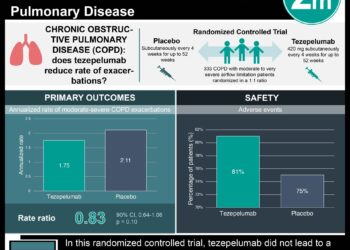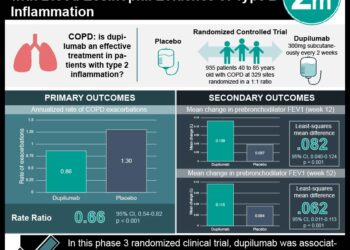CT and MR imaging measurements reflect symptoms of progressive lung disease
1. In patients with mild-to-moderate chronic obstructive pulmonary disease (COPD), pulmonary MRI and CT imaging identified disease phenotypes, exercise limitations and predicted symptomology, particularly in patients with minimal FEV1 abnormalities.
2. Hyperpolarized 3He MR imaging, lung diffusion capacity and plethysmographic measurements were most predictive of exertional dyspnea symptoms, while FEV1 was an insignificant predictor except in more severe disease.
Evidence Rating Level: 2 (Good)
Study Rundown: Pulmonary function tests are frequently used in the diagnosis of chronic obstructive pulmonary disease (COPD), a combination of chronic bronchitis and emphysema common in smokers and strongly associated with exertional dyspnea and subsequent activity limitations. Plethysmographic measurements are considered the gold standard in the assessment of this disease, including the forced expiratory volume (FEV1), a measurement of the volume of air breathed out forcefully during the first second of exhalation. While conventional, this measure does not provide a comprehensive nor direct picture of COPD, in which some patients classified as having mild disease may in fact have severe limitations while others experience few symptoms. The clinical utility of information obtained from imaging studies for COPD assessment has been gaining interest and is the target of this study, which sought to determine the role of imaging in airway disease and whether CT and MRI measurements could predict COPD symptoms more accurately than FEV1, patients with mild-to-moderate COPD. Selected patients underwent conventional CT, inhaled hyperpolarized 3He MRI, and for comparison, completed a symptom based questionnaire, pulmonary function testing and exercise tolerance testing. The measurements generated from imaging and pulmonary function tests were compared to patient-reported quality of life data and exercise capacity results from the exercise tolerance test. The results revealed that both MRI and CT can provide helpful information about COPD symptoms, with apparent diffusion coefficient (ADC) derived from MR imaging being the most significant predictive factor of exertional dyspnea in multivariate modeling of symptom scoring questionnaire score for mild-to-moderate severity COPD patients, while FEV1 and directly airway disease measurements were not predictive. The findings in this single-center study are limited by its reliance on the 6 minute walking test, which has demonstrable variability amongst COPD patients and may introduce a confounder within the quality of life self-reports from participants.
Click to read the study in Radiology
Relevant Reading: Using pulmonary imaging to move chronic obstructive pulmonary disease beyond FEV1
In-Depth [prospective cohort]: 116 patients with mild-to-moderate COPD (mean age 70±9, 62% male) with a mean smoking history of at least 10 pack-years were included in the study. Of these patients, 80 subjects had COPD classified as “mild-to-moderate” and 36 were classified to be “severe” as defined by Global Initiative for Chronic Obstructive Lung Disease (GOLD) criteria. These patients underwent spirometry, plethysmography, conventional CT and inhaled noble gas MRI. They also completed the St. George’s Respiratory Questionnaire (SGRQ) which measures quality of life in terms of symptoms, and the 6-minute walk test. In mild-to-moderate COPD patients with modestly abnormal FEV1, the results showed that MRI findings were strongly correlated with exercise limitation, while both CT and MRI measurements were descriptive of the symptoms reported by the patients on the SGRQ. Using multivariate modeling, FEV1 was predictive of patient exercise capability on a 6-minute walk test (b = 0.34, p = 0.01) for the 36 patients with severe COPD. However, for the 80 participants with mild-to-moderate COPD, FEV1 was not useful in symptom assessment. Hyperpolarized helium apparent diffusion coefficient (b = 0.34, p = 0.04), diffusing capacity of the lung for carbon monoxide (b = 0.60, p = 0.0008), and residual volume/total lung capacity (b = −0.26; p = 0.02) were found to be useful measurements to describe symptoms. To predict symptom scores on the SGRQ, hyperpolarized helium apparent diffusion coefficient (β, 0.60; P = .005), relative area of the CT attenuation histogram with attenuation of −950 HU or less (b = −0.52; p = 0.02), and FEV1 (b = −0.45; p = 0.0002) were each found to be significant predictors. The apparent diffusion coefficient was the most significant (b = 0.95; p = 0.01) for severe COPD, followed by relative area of the CT attenuation histogram with attenuation of −950 HU or less (b = −0.62; p = 0.07) and CT airway count (b = −0.49; p = 0.01).
Image: PD
©2015 2 Minute Medicine, Inc. All rights reserved. No works may be reproduced without expressed written consent from 2 Minute Medicine, Inc. Inquire about licensing here. No article should be construed as medical advice and is not intended as such by the authors or by 2 Minute Medicine, Inc.





![Transplantation of genetically altered stem cells improves bone formation in mice [PreClinical]](https://www.2minutemedicine.com/wp-content/uploads/2015/07/1280px-Medical_X-Ray_imaging_BMJ02_nevit-75x75.jpg)
